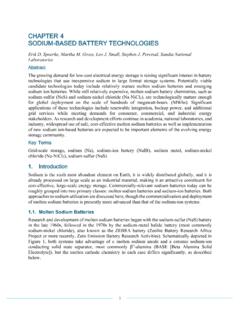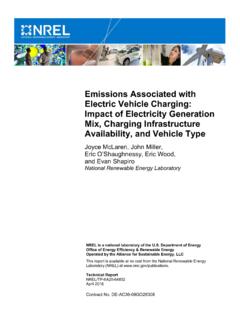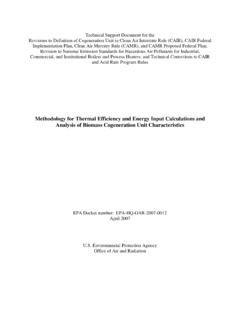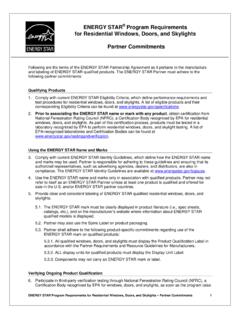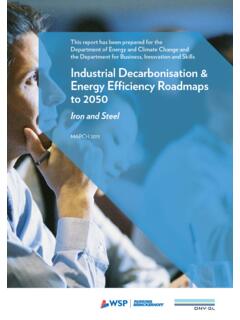Transcription of Energy Storage Systems Overview of the Technology, Safety ...
1 Energy Storage Systems Overview of the Technology, Safety Related Issues and Codes/Standards SAND2017-4428 C PNNL-SA-125788. Purpose and Expected Outcome Purpose To introduce new and emerging Energy Storage technologies, Safety -related issues, and how those issues are being addressed. Expected Outcomes A basic understanding of Energy Storage technologies FUNDAMENTALS. Identification of Safety -related issues associated with Energy Storage Systems Safety ISSUES. Identification of the standards and codes applicable to Energy Storage Systems and what they cover CODES AND STANDARDS Source - Southern California Edison Knowledge about the various applications for Energy Storage in the built environment APPLICATIONS. FUNDAMENTALS. Energy Storage Fundamentals An Overview of the . Market drivers for Energy Storage Basic functions of the different types of Energy Storage Systems 3.
2 DRIVERS. Market Drivers Energy supply does not exactly track with or match demand. Energy produced from renewable, waste heat and other Energy sources may not be acceptable for its intended use. Energy cost may change between peak and off-peak periods making it advantageous to buy low and use high.. More traditional sources of Energy may have periods when they are not readily available. Consumers want to move off the grid.. Utilities need to more effectively operate and improve the grid. 4. DRIVERS. policy Incentives and Mandates The demand for Energy Storage can be accelerated through policy initiatives and incentives that provide needed support until the market matures. Install gigawatts of Storage capacity in New York City CA PUC initiative MA Storage requirement OR Storage requirement 5. DRIVERS. Energy Storage Projected Deployment Source Green Tech Media Inc.
3 6. BASICS. What is Energy Storage ? 7. BASICS. Energy Storage Technologies Energy long discharges (min to hr) ala a 10K . Pumped Hydro Compressed Air Energy Storage (CAES). Electrical Storage (Batteries). Sodium Sulfur (NaS). Flow Batteries Lead Acid Advanced Lead Carbon Lithium Ion Flywheels Electrochemical Capacitors Power short discharges (sec to min) ala a 100 m sprint . 8. 8. Global Energy Storage Deployments BASICS. (Battery Only). Na-Metal, 156. Pb-acid, 139MW Li-ion, 714MW. 9. BASICS. Battery Basics Batteries store Energy chemically and through electrochemical reactions produce electricity. The presence of an anode, cathode, and electrolyte provides the basis for storing Energy and satisfying Energy loads. There are a wide range of battery types, sizes, designs, operating temperatures, control mechanisms, and chemistries.
4 Beyond storing Energy , all batteries are not created equal. Source Kamath, EPRI ES Technology Overview 10. BASICS. Battery Terminology Electrochemical Cell: Cathode(+), Anode (-), and Electrolyte (ion- conducting intermediate). Efficiencies Columbic Measure of difference in charge/discharge Voltage Function of internal resistance Energy CE x VE. Energy (kWh) = Voltage (V) difference between anode and cathode multiplied by amount of ion the electrodes are able to store given as Amp-hours (Ah) of capacity Energy Density (Wh/kg or Wh/L): Used to measure the Energy density of a battery Low cost/ubiquitous Note: Number often given for cell, pack, and system Generally: Pack = cell Energy density, and system is fraction of the pack 11. BASICS. Lead-Acid (LA) Batteries Two electrodes (one lead and one lead-dioxide) immersed in sulfuric acid Pros Low cost/ubiquitous Mature technology Familiar Cons Limited lifetime and degradation w/ deep discharge Poor cycle life/need for replacement Often needs maintenance Low specific Energy (30 50 Wh/kg) Includes Overcharging leads to H2 evolution SLI.
5 Sulfation from prolonged Storage Flooded SLA. Valve-regulating LA. 12. BASICS. Nickel-Cadmium (Ni-Cd) Batteries Two electrodes (one nickel and one cadmium) immersed in an aqueous potassium-hydroxide electrolyte Pros Mature technology Relatively rugged Greater Energy density than LA. batteries Better life cycle than LA batteries Cons More expensive than LA batteries Safety Thermal runaway Contains cadmium 13. BASICS. Lithium Ion (Li-ion) Batteries Pros Decreasing costs Stationary on coattails of increasing EV. Ubiquitous Multiple vendors. Fast response. Higher efficiency. Cons High temperature. Typical operating window 0 50 C. Operation above this Parasitic loads like HVAC. temperature can lead to often are not included. organic electrolyte Overcharging: Max voltage decomposition and depends on materials;. flammable gas. overcharging can lead to Li Different chemistries have metal plating on anode, different heat generation.
6 Potential for short. 14. BASICS. Na-Metal Batteries Basic Chemistry Batteries consisting of molten sodium anode and "-Al2O3 solid electrolyte (BASE). Use of low-cost, abundant sodium low cost High specific Energy density (120~240 Wh/kg). Good specific power (150 230 W/kg). Good candidate for Energy applications (4 6 hr discharge). Operated at relatively high temperature (300~350 C). Sodium-sulfur (Na-S) battery 2Na + xS Na2Sx (x = 3~5). E = ~ V at 350 C. Sodium-nickel chloride (Zebra) battery 2Na + NiCl2 2 NaCl + Ni E = at 300 C. Use of catholyte (NaAlCl4). 15. BASICS. Na-Metal Batteries Temperature Fewer over-temperature concerns; typical operating window 200 350 C; additional heaters needed when not in use. At <98 C, Na metal freezes out; degree of distortion to cell dictated by SOC of battery (amount of Na in anode). Charging/Discharging Limitations Safety Concerns Low cost/ubiquitous.
7 Solid ceramic electrolyte keeps reactive elements from contact. Failure in electrolyte can lead to exothermic reaction (Na-S). 16. BASICS. Redox Flow Battery: Basic Chemistry Key Aspects Energy supply does not exactly track with or match demand. Power and Energy are separate, thereby enabling greater flexibility and Safety . Suitable for wide range of applications 10's MW. to ~ 5 kW. Wide range of chemistries available. Low Energy density ~30 Wh/kg. Lower Energy efficiency. 17. BASICS. Redox Flow Batteries Temperature High/low temperatures can lead to precipitation of species Typical range -10 60 C. Charging Overcharging can lead to evolution of hydrogen (H2O. electrolysis). Toxicity of Elements Solutions are in a pumped system, susceptible to leaks Minimal Fire Hazard Electroactive element in aqueous solution High Degree of Flexibility 18.
8 BASICS. Thermal and Mechanical Systems Pumped Hydroelectric Storage Energy is stored in the form of a water reservoir at a higher altitude that is released through turbines to a lower reservoir. During low Energy demand the water is pumped back up to the higher reservoir. Pros Large-scale and mature technology (20+ GW in USA, 129+ GW worldwide). Long-term Storage Cons Requires water and specific geography availability Safety Issues Overfilling DOE/EPRI 2013 Electricity Storage Handbook in Collaboration with NRECA. Containment failure 19. BASICS. Thermal and Mechanical Systems Flywheels A spinning mass in its center that is driven by a motor. When Energy is needed, the spinning force drives a turbine, which slows the rate of rotation. The system is recharged by the motor increasing its rotational speed. Pros Fast charge/discharge (<5 ms).
9 No hazardous materials Cons Not attractive for large-scale or long-term Storage SAND2015-10759 Recommended Practices for the Safe Design and Operation of Flywheels . 20. BASICS. Flywheels Safety Issues Rotor Failure: energetic projectiles Mitigation 2X design margin Containment not cost-effective 10X mass required to contain Loose Rotor: unintended Energy release Failure of bearing, shaft, or hub Mitigation prevent contact between rotor and housing, manage Energy release 21. FUNDAMENTALS. Key Takeaways There are a wide range of Energy Storage technologies today and there will be more in the future. Energy , economic. and environmental issues are creating a demand for Energy Storage , and policy initiatives are accelerating that demand. Energy Storage includes batteries but also thermal and mechanical technologies. Beyond storing Energy , all batteries are not the same.
10 The wide range of battery types, chemistries, sizes, designs, control mechanisms, operating temperatures and potential locations suggest an almost infinite number of possibilities. Just when you think you have all the information you need there will be new Energy Storage technologies to keep you engaged. 22. Safety ISSUES. What Are the Safety Issues? Identifying the Safety issues that are relevant to Energy Storage Systems Energy supply does not exactly track with or match demand. Siting (location, loads, protection, egress/access, maximum quantities of chemicals, separation, etc.). New versus existing Systems and new versus existing building/facility applications. Ventilation, thermal management, exhausts (when necessary, flow rates, how controlled, etc.). Interconnection with other Systems ( Energy sources, communications, controls, etc.)




